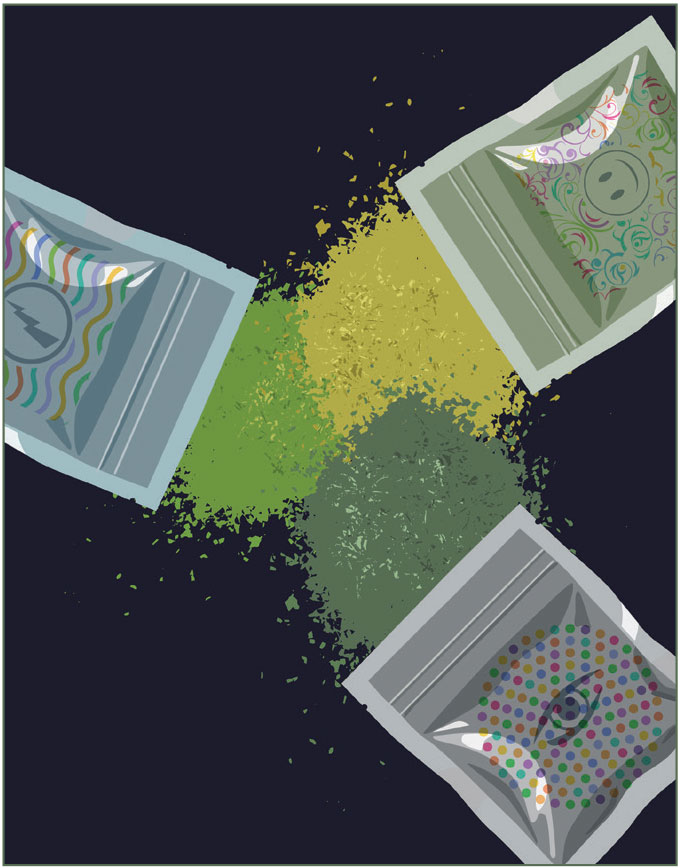
by Rajashekar Reddy Yeruva, MD; Hema Madhuri Mekala, MD; Meesha Sidhu MD; and Steven Lippmann, MD
Drs. Yeruva and Lippmann are with the University of Louisville School of Medicine in Louisville, Kentucky. Drs. Mekala and Sidhu are with Griffin Memorial Hospital in Norman, Oklahoma.
Funding: No funding was provided.
Disclosures: The authors have no conflicts of interest relevant to the content of this article.
Abstract: Synthetic cannabinoids, popularly called Spice, are common drugs of abuse in the United States. They are utilized as a substitute for marijuana, primarily for their psychoactive properties. Consumption has been rapidly increasing due to recreational effects, easy accessibility, and not being detectable by urine drug screening tests. The side effect profile of synthetic cannabinoids involves many organs and is not well known to the public. Psychoses are a common adverse result from their consumption. Primary care physicians and other medical professionals should consider synthetic cannabinoid consumption in the differential diagnoses of a patient presenting with psychosis.
Keywords: synthetic cannabinoids, Spice, K2, adverse events, psychosis, schizophrenia, long-term outcomes
Innov Clin Neurosci. 2019;16(1–2):31–32
Synthetic cannabinoids (SC) are a public health concern due to their adverse effect and limited safety profile research. Synthetic marijuana products first appeared as recreational drugs in Europe in 2006, and consumption has increased in the United States since 2009.1 SC is added to various herbal products and marketed as marijuana alternatives. SC distribution is rising, readily available over the counter and via the internet.2 The United States Drug Enforcement Administration (DEA) labeled SC products under Schedule 1; thus, SC is categorized as an illegal substance.3 Various compositions of SC have been synthesized and distributed in the US, despite governmental restrictions.4 Young people are the most frequent users, which has been attributed to the recreational effects of SC, as well as its easy accessibility and difficulty in being detected in the urine by drug screening.5
Epidemiology
SC was developed to study cannabinoid receptors but emerged as a substance of abuse.6 Wrapped in foil packages, SC has been marketed as nail polish remover, deodorizers, incense, and potpourri, offering a “natural, legal high,” but “not for human consumption.” Collectively referred to as “Spice” or “K2,” SC typically contains a mixture of synthetic cannabinoids including CP-47, 497, CP-47,497-C8, JWH-018, JWH-073, JWH-081, JWH-122, JWH-210, JWH-250, HU-211, and RCS-4.7 Although sold as a marijuana “alternative,” SC has been linked to more adverse health effects than natural cannabinoids. Adolescents, in particular those who are male and/or African-American, account for 40 percent of all users, and many first-time users of SC are reported to have previously smoked marijuana.9 SC consumption is most frequent among people who are either single, divorced, separated, homeless, and/or unemployed.9 Poison control centers receive thousands of reports of adverse health effects related to SC annually. Recently, the Illinois Department of Public Health reported cases of bleeding and deaths due to contamination of SC with rat poison.10 They issued an alert not to use SC purchased since March 1, 2018.
Pharmacology
SC binds to CB1 and CB2 cannabinoid G protein-coupled receptors with effects similar to tetrahydrocannabinol (THC). These receptors are widely distributed throughout the body—CB1 being predominant in the brain and CB2 in the immune system.11 The CB1 receptor is primarily responsible for psychoactive effects, while the CB2 receptor is involved in immune function. THC acutely increases dopamine release and neuronal activity, while long-term exposure is associated with blunting of dopamine; THC can induce diverse, potentially long-term effects on this system.4 In contrast to THC being a partial agonist at brain cannabinoid receptors, SC is a full agonist, with high potency at CB1 receptors.12
Adverse Events
Adverse outcomes associated with SC consumption are more prevalent and severe than those arising from natural cannabis use.13 There has been an increase in emergency medical treatment due to ill effects secondary to synthetic cannabinoids.14 High receptor binding affinity might be explanatory. Adverse events include the following:
- Fatality: Death has been attributed directly to SC due to cardiac dysrhythmias, seizures, liver toxicity, and/or kidney failure; deaths have also been related indirectly to SC use due to hypothermia15
- Cardiovascular: Effects include tachycardia, hypertension, arrhythmia, myocardial infarction, and/or cardiac arrest.15
- Renal: Effects include acute tubular necrosis, interstitial nephritis, and/or rhabdomyolysis.15
- Gastrointestinal: Effects include nausea and vomiting.15
- Neurologic: Effects include agitation, irritability, catatonia, seizures, sedation, cognitive deficits, memory loss, sympathomimetic syndrome, and coma. Additionally, structural abnormalities including subarachnoid hemorrhage and cerebrovascular accidents have been linked to SC usage.14–17
- Psychiatric: Effects include altered mental status, anxiety, panic, and psychoses. Symptoms have been reported to persist for over one month following ingestion, with psychiatric hospitalizations reported due to suicidality, affective symptoms, self-injury, catatonic features, and/or Capgras syndrome.
- Bleeding: Patients with SC poisoning evidence hemoptysis, hematuria, bloody noses, bleeding gums, and/or internal hemorrhage. Patients presenting with brodifacoum, a dangerous anticoagulant contained in some rat poisons, has also been reported.10
Psychosis
Reported psychotic symptoms associated with SC ingestion include perceptual alterations, illusions, paranoia, catatonia, depersonalization, dissociation, and auditory and/or visual hallucinations. Psychoses are usually transient and resolve spontaneously; however, these reactions appear to be a frequent reason for individuals to seek emergency medical attention.
The psychoses associated with SC ingestion can impact the determination of long-term mental health prognoses. The degree of SC-associated dysfunction is related to age of exposure, familial aspects, psychiatric predispositions, childhood trauma, and genetic factors.14 Younger male users using SC appear to experience more psychotic symptoms compared to those who use marijuana.18 Psychosis can persist even without a history of mental illness and has been reported to develop into chronic schizophrenia.12
Neurophysiology studies document similarities between disruptions of neuronal network oscillations in schizophrenia and psychosis and those conditions triggered by SC.11 There are more psychotic symptoms and agitation among SC users than in those ingesting cannabis. SC use has been observed to result in diagnosable psychotic disorders requiring more pharmacotherapy with antipsychotic medications and/or longer psychiatric hospitalizations compared to marijuana or natural cannabis use.9
Comment
Due to the potentially serious consequences that can occur with SC use, medical professionals, governmental agencies, and the general public should work together to mitigate these dangers. The increase in cases of acute SC poisoning underscores the need for targeted prevention and treatment interventions. The chemical composition of SC has been altered to avoid being detected on urine screening; thus, assays specific for SC detection should be considered when screening select populations for substance use. Educating the public on the potentially life-threatening consequences of SC exposure is important. Expanding services for chemical dependence treatment is in the public interest.
Acute SC intoxications are managed by hospitalization, close monitoring, and supportive therapies, such as hydration, airway protection, and/or oxygen. Agitation can be quickly managed by intravenous benzodiazepines infusions. Psychotic symptoms can be controlled with antipsychotic medications, with careful consideration of individual patient needs.19
References
- Weinstein AM, Rosca P, Fattore L, et al. Synthetic cathinone and cannabinoid designer drugs pose a major risk for public health. Front Psychiatry. 2017;8:156.
- Dresen S, Ferreirós N, Pütz M, et al. Monitoring of herbal mixtures potentially containing synthetic cannabinoids as psychoactive compounds. J Mass Spectrom. 2010;45(10):1186–1194.
- United States Drug Enforcement Administration Department of Justice. Schedules of controlled substances: temporary placement of four synthetic cannabinoids into Schedule I. Final order. Fed Regist. 2014;79(27):7577–7582.
- Bloomfield MA, Ashok AH, Volkow ND, et al. The effects of Delta9-tetrahydrocannabinol on the dopamine system. Nature. 2016;539(7629):369–377.
- Mathews EM, Jeffries E, Hsieh C, et al. Synthetic cannabinoid use among college students. Addict Behav. 2019;93:219–224.
- Trecki J, Gerona RR, Schwartz MD. Synthetic cannabinoid-related illnesses and deaths. NEJM. 2015;373(2):103–107.
- Castaneto MS, Gorelick DA, Desrosiers NA, et al. Synthetic cannabinoids: epidemiology, pharmacodynamics, and clinical implications. Drug Alcohol Depend. 2014;144:12–41.
- Fattore L. Synthetic cannabinoids-further evidence supporting the relationship between cannabinoids and psychosis. Biol Psychiatry. 2016;79(7):539–548.
- Bassir NA, Medrano B, Perkel C, et al. Psychiatric comorbidity associated with synthetic cannabinoid use compared to cannabis. J Psychopharmacol. 2016;30(12):1321–1330.
- Illinois Department of Public Health (IDPH). 9 May 2018. http://dph.illinois.gov/topics-services/preventionwellness/medical-cannabis/synthetic-cannabinoids. Last accessed 08 March 2019.
- Davidson C, Opacka JJ, Arevalo MA, et al. Spicing up pharmacology: a review of synthetic cannabinoids from structure to adverse events. Adv Pharmacol. 2017;80:135–168.
- D’Souza DC, Radhakrishnan R, Sherif M, et al. Cannabinoids and psychosis. Curr Pharm Des. 2016;22(42):6380–6391.
- Riederer AM, Campleman SL, Carlson RG, et al. Acute poisonings from synthetic cannabinoids—50 U.S. toxicology investigators consortium registry sites, 2010-2015. MMWR Morb Mortal Wkly Rep. 2016;65(27):692–695.
- Radhakrishnan R, Wilkinson ST, D’Souza DC. Gone to pot—a review of the association between cannabis and psychosis. Front Psychiatry. 2014;5:54.
- Tait RJ, Caldicott D, Mountain D, et al. A systematic review of adverse events arising from the use of synthetic cannabinoids and their associated treatment. Clinical Toxicol (Phila). 2016;54(1):1–13.
- Zorlu N, Angelique DM, Kalayci CC, et al. Abnormal white matter integrity in synthetic cannabinoid users. Eur Neuropsychopharmacol. 2016;26(11):1818–1825.
- Khan M, Pace L, Truong A, et al. Catatonia secondary to synthetic cannabinoid use in two patients with no previous psychosis. Am J Addict. 2016;25(1):25–27.
- Shalit N, Barzilay R, Shoval G, et al. Characteristics of synthetic cannabinoid and cannabis users admitted to a psychiatric hospital: a comparative study. J Clin Psychiatry. 2016;77(8):e989–e995.
- Roberto AJ, Lorenzo A, Li KJ, et al. First-episode of synthetic cannabinoid-induced psychosis in a young adult, successfully managed with hospitalization and risperidone. Case Rep Psychiatry. 2016;2016:7257489.





